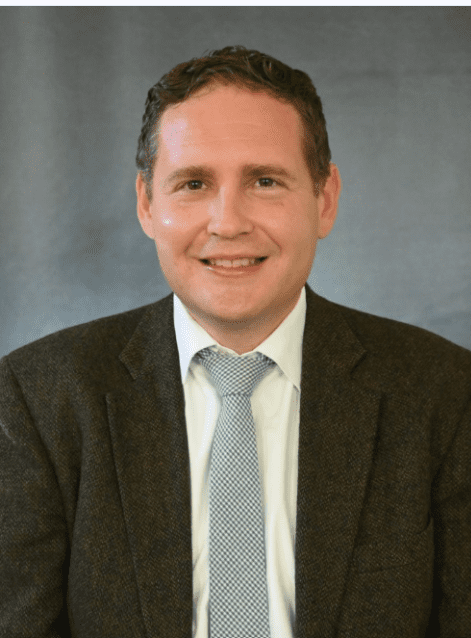It’s not easy to get through 2,000 years of theological, political and cultural history in an hour and 15 minutes.
It’s also not easy to select only 20 pieces of art in the Basilica of St. Josaphat — a treasure trove of liturgical and architectural grandeur — to talk about.
Dr. Paul Monson was more than up to the task, as he led an audience through 20 centuries of Catholic history by focusing on 20 different objects in the Milwaukee Basilica on Wednesday, June 5. Dr. Monson’s talk, entitled “20 Centuries in 20 Objects: The History of the Church through the Art and Architecture of the Basilica of St. Josaphat,” served as the inaugural address in the Stillman Lecture Series, which will be presented at the Basilica by the Wethersfield Institute.
Dr. Monson is the Vice President of Intellectual Formation and Academic Dean at Sacred Heart Seminary and School of Theology in Hales Corners. A parishioner of the Basilica, he earned his master’s degree and his Ph.D. from Marquette University, and as an associate professor of church history at SHSST, is responsible for teaching church history to virtually every seminarian who goes on to be ordained for the Archdiocese of Milwaukee.
Dr. Monson divided his lecture into four sections, each focused on a 500-year period of church history. Each section was centered on a specific question that the faithful during that period were seeking to answer. For the years 1 through 500 A.D., that question was “Who is Christ?” For the years 500 through 1000 A.D., the question was “How do we worship Christ?” The years 1000 through 1500 A.D. were defined by the question “How do we become like Christ?”
Finally, dialogue within the Catholic Church, in years between 1500 and 2000 A.D., was animated by the question “How do we bring Christ to the world?”
Church history, said Dr. Monson, is “full of surprises” and the 20 (approximately) objects he chose illustrated the development of church tradition over the centuries — and the surprises that presented themselves along the way.
Here are just a few of the objects he highlighted, and the historical significance they represented.
— The ambo and altar of the Basilica — representing the Word of God and sacrificial offering to him, elements which were central to Jewish worship — emphasize the Jewish roots of the Christian tradition.
— The Basilica as a whole building represents how the combination of Greek and Latin influences defined the early church; the word “basilica” is derived from the Greek word for “hall of the king,” while the architectural style is decidedly Roman.
— Dr. Monson drew the audience’s attention to the words of “Pater,” “Filius” and “Spiritus Sanctus” painted on the ceiling above the altar and on either side of the transept. The question of Jesus’ divinity and his exact role within the Trinity was addressed in the fourth century, most notably in the Council of Nicaea in 325, which gave rise to “a word that almost destroyed the Church,” said Dr. Monson. That word? “Consubstantial.”
— Looking to the many representations of the Blessed Mother throughout the Basilica, Dr. Monson spoke about the early Church’s need to grapple with the concept of what it means to be “the mother of God” — and what that fact would mean for the divinity of Jesus. The fathers of the Council of Ephesus in 431 affirmed Mary as “Theotokos” — Mother of God — and that Christ is “consubstantial with us in his humanity,” said Dr. Monson, as well as consubstantial with the Father in his divinity.
— The confessionals on the east and west sides of the nave gave Dr. Monson an opportunity to address the development of the Sacrament of Penance, which, prior to the seventh century, was a largely public practice. But in the 600s and after, thanks to practices implemented by Irish monks like St. Columban, it developed into a more personalized, private encounter between the priests, representing Christ, and the penitent.
— Pointing to the tabernacle, Dr. Monson spoke of how the reservation of the Eucharist after worship is an ancient practice but noted that it was not until the 1100s that a public space for worship of the Blessed Sacrament outside of Mass became the norm.
— The communion rail at the side altars gave rise to a discussion of the Reformation, which began in 1517. It was during this time, said Dr. Monson, that the question of Christ’s presence in the Eucharist really dominated theological debate. After the Reformation, there was a greater effort to bring the Eucharistic sacrifice into the view of the people. During this time, St. Charles Borromeo popularized bringing the tabernacle into the center of the high altar.
— Above the west sacristy door, the “Miracle of the Vistula” painting depicts Cardinal Achille Ratti (the future Pope Pius XI) praying for victory against the Bolshevik army in 1920. Pope Pius XI would eventually name the Basilica of St. Josaphat a minor basilica in 1929, the same year of the Lateran Treaty, which declared Vatican City an independent state. The Lateran Treaty, and the dissolution of the Papal States which preceded it, saw a transition in how Catholics around the world related to the pope. He became less of a political figure and even more of a global spiritual father. “How we think of popes today comes out of recent church history,” said Dr. Monson.
The Milwaukee-based Wethersfield Institute, whose mission is to “bring to light the Church’s rich intellectual, liturgical and cultural treasures,” is planning several more installments of the Stillman Lecture Series this fall. For more information, visit wethersfieldinstitute.org.

Dr. Paul Monson
